Chapter 13 Transformations in Asia and Africa on the Eve of European Overseas Expansion
Section
5
The collapse of
the Mongol Empire in the 14th century once again left eastern
Asia at least partially isolated from the rest of Eurasia. As the Chinese
reacted against the foreign rule of the Mongols, the new Ming dynasty did
its best to restore what it considered the traditional values and policies
of the Middle Kingdom. Although at first this included continuing the
expansion of China’s sea power and overseas trade, as internal recovery
proceeded, and the pressing threat of invasion from the north and west
re-emerged, the Ming emperors eventually withdrew from the sea and focused
their attention inward. Similar policies were also followed by their
successors, the foreign, Manchu emperors of the early Qing dynasty.
The Ming
Dynasty
In 1368, a new Chinese leader emerged to overthrow
the Yuan dynasty of the Mongols. Zhu Yuanzhang was born a peasant in
southern China. As a child his life was hard, and often he went hungry.
Eventually he learned to read and write from Buddhist monks, and as a
young man he joined a militantly anti-Mongol secret society. As he grew
older he began to gather a military following and became a warlord in
rebellion against Mongol rule. In 1365 his forces captured the city of
Nanking on the Yangzi River, where Zhu set up a government and called for
the complete eviction of the foreign “barbarians.”
“The Middle Kingdom has always been considered the center of government, from which the emperors and kings rule over the barbarians. The barbarians are left outside but they are subject to the Middle Kingdom. It is unheard of that barbarian tribes have ever come to rule the universe.”
As he became more successful, Zhu also drew followers
from among the Confucian scholarly class, who instructed him in the
rituals that were necessary for him to claim the Mandate of Heaven. With
this kind of support, in 1368 Zhu Yuanzhang drove out the last of the
Mongol overlords and ascended the imperial throne as the Hung Wu, or
“Great Military,” Emperor. Thus began the Ming, or “Brilliant,”
dynasty in China.
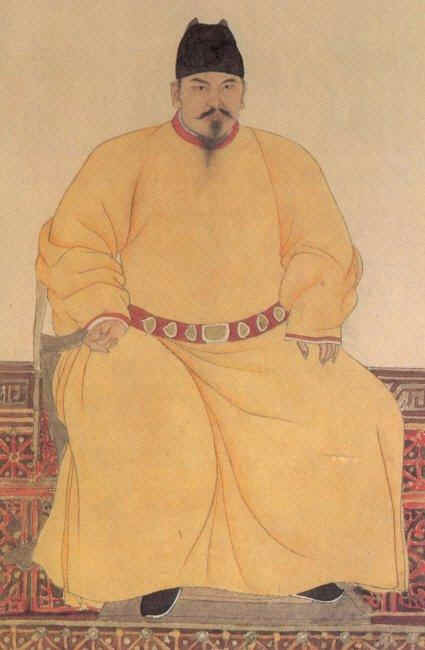
Zhu Yuanzhang, also known as Emperor Tai Zu, or the Hung Wu ('Great Military') Emperor, founder of the Ming Dynasty. Taken from http://www.paulnoll.com/China/Dynasty/Ming-1368-Tai-Zu.html
Reforms of the Hung Wu Emperor. The Hung Wu emperor spent the next decade and a half reuniting all China. Eventually, they firmly secured the emperor’s rule from Korea in the north to Vietnam in the south. States around China’s borders were once again forced to acknowledge the authority of the emperor and their own status as tributaries of the Middle Kingdom.
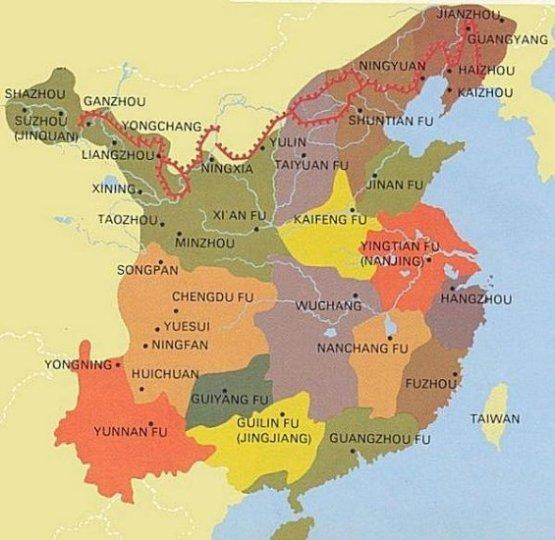
Ming
Dynasty Map (AD 1368 to 1644 - 277 Years)
Anxious to restore the “traditional” sense of Chinese identity, Hung Wu reinstated the official examination system for the bureaucracy. The Ming were the first to restrict government service to those who had passed the examinations. Having been a peasant himself, however, the emperor viewed the scholar-gentry with some suspicion, and the examination system was expanded to allow people from all levels of society to participate.
Understanding their plight better than most, Hung Wu also did his best to make life easier for the peasants. He cut taxes on the land to extremely low levels. He also began large-scale programs to plant trees for erosion control where necessary, and to repair and maintain the dams and dikes on the Yangzi and Yellow Rivers. With lower taxes, however, the government itself suffered considerably. Officials were paid little. What revenues there were, the emperor used primarily for maintaining the military in order to prevent any further nomadic incursions.
Hung Wu further undermined the upper levels of the bureaucracy by reorganizing the government. Discovering that his prime minister was apparently plotting against him, he ordered the man beheaded—along with his entire family and everyone associated with them. (Under the Chinese system of extended family relationships, over the years this meant that nearly 40,000 people were executed.) At the same time, he abolished the office and central secretariat of the prime ministership and took full military and civilian control into his own hands.
Weakness of Ming administration. Although he warned that “eunuchs should not be allowed to interfere with affairs of state; death to the offender,” Hung Wu’s own actions fostered just such a development, particularly under his weaker successors. With the prime minister’s office and the secretariat abolished, emperors increasingly relied on the eunuchs of their personal household to carry on administration at the top. Eventually there were some 70,000.
As the eunuchs interfered with upper levels of administration,
inefficiency and corruption became almost institutionalized and a kind of
paralysis set in at the top of Ming government. Ironically, such paralysis
at the top only made it easier for the traditional scholar-gentry
bureaucracy to return to full power in the lower levels of government.
Matteo Ricci, a Christian missionary in China during the mid-1500s,
described their role in his Journals:
“The entire kingdom is
administered by the Order of the Learned, commonly known as the
Philosophers. The responsibility for orderly management of the entire
realm is wholly and completely committed to their charge and care. The
army, both officers and soldiers, hold them in high respect and show them
the promptest obedience and deference, and not infrequently the military
are disciplined by them as a schoolboy might be punished by his master.”[11]
Such controls, however, were ultimately disastrous for China. In
his determination to eradicate all foreign influences Hung Wu had accepted
the most rigid and conservative Neo-Confucian doctrines that had been
developed by the scholar Chu Hsi in the Sung period as the basis of the
examination system. Under the scholars’ neo-Confucian doctrines,
innovation and change were discouraged. As one official put it in the
mid-1500s: “The truth has been made manifest. . . . No more writing is
needed.” Ming government soon seemed to function along precisely these
lines.
Developments in Chinese society. Under the early Ming emperors, China initially continued to flourish as it had done under the Sung. Ming emperors did their best to help those areas of China that had suffered most under the Mongol conquest and the ravages of the plague, to recover their prosperity. They provided free seeds, tools, and land, to help refugees resettle. In addition, as contacts developed with the outside world, new food crops, such as peanuts, sweet potatoes, and maize came to China from the Americas. Soon the population began to grow again—from about 60 million people in the mid-1300s to about 200 million around 1600.
With this rise in population, Chinese cities also expanded. Beijing, for example, which the Yongle emperor made his capital, had over 700,000 inhabitants. Hangchow and Nanking in the south had over a million each. The largest Chinese city, Soochow, had over two million inhabitants. Smaller cities also developed, some as specialized manufacturing centers. One Chinese city in the province of Kiangsi, for example, had nearly 3,000 porcelain factories.
As Chinese production increased, so too did trade. Merchants became extremely wealthy. However, in their efforts to re-impose “traditional” Confucian society, both the Ming and the scholar-gentry revived the old social prejudices against merchants and traders as mere “parasites.” In an effort to overcome this disadvantage, more and more merchants tried to use their wealth to buy land and join the gentry. Many paid large sums of money to the scholar-gentry to provide their sons with an education that would enable them to do well in the examinations system. Sometimes, a merchant would simply buy his son’s way into offices with large bribes.
Despite the growth in city life, however, the vast bulk of the Chinese people remained peasants living in villages in the countryside, from which they went out every day to farm the fields. In addition, despite Ming efforts to improve their lot, increasingly these villagers found themselves becoming tenants of wealthy, large-scale landlords, as the gentry began to expand their land holdings.
The conservative attitudes of the Confucian bureaucracy also
extended to the position of women. Reacting against the greater freedom
Mongol women had enjoyed, the Ming reasserted the subordinate status of
women in Chinese society. Above all, their status depended on being able
to have male children, which would eventually allow them to move from
being a daughter-in-law to being a mother-in-law. Foot binding, which
Mongol women had refused to do, once again became an expected part of a
Chinese girl’s effort to find a suitable husband.
Early Ming seapower. In part, the growing prosperity of the merchant class in China was due to the continuation of favorable trade policies begun during the T’ang and Sung dynasties and continued under the Mongols. Chinese sea power continued to grow in the early years of the dynasty. The height of this power came under the third Ming emperor, the Yongle emperor. At the same time that he was fighting Mongols on the northern borders, Yongle also sent his Grand Eunuch, Zheng He, on major naval expeditions into Southeast Asia and the Indian Ocean.
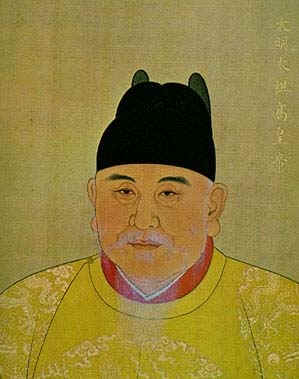
Zheng He, Grand Eunuch and Admiral of the Ming navy. Taken from http://www.legit-site.com/people/ZhengH.html
Between 1405 and 1433, Zheng He mounted the largest naval expeditions ever seen. There were seven expeditions in all. The first involved a fleet of some 317 ships. 67 of them were “treasure ships” that measured between 370 and 440 feet in length and 150 to 180 feet across. Some carried as many as nine masts, up to 90 feet high. They were also built with watertight compartments that minimized the dangers of sinking. Sternpost rudders made them much easier to steer at sea than the side-oar steering still being used by European and some Arab sailors. The personnel were as impressive as the ships. In addition to the Grand Eunuch himself, the fleet carried a staff of about 70 other eunuchs, 180 physicians, and 300 military officers commanding some 26,800 men. There were even 5 official astrologers.
Following the normal overseas trade routes, Zheng He visited India
and the ports in between on his first three voyages. On the fourth visit
he went as far as Hormuz, and on the last three the fleets sailed along
the east African coast. Detachments of the fleets made other short trips
as well—one for example took Zheng He, who was a Muslim, to the Arabian
coast, from where he made the pilgrimage to Mecca. The voyages were not
trading ventures, however. Rather they were primarily diplomatic missions.
Zheng He established relations with some 30 countries, convincing some to
become tributaries of the Ming emperor and settling disputes for others.
When necessary, he landed troops to make clear to some local rulers the
authority of the Chinese emperor. He also gathered considerable
geographical information and brought back items of curiosity for the
emperor’s amusement. On one trip, for example, he brought back a
giraffe.
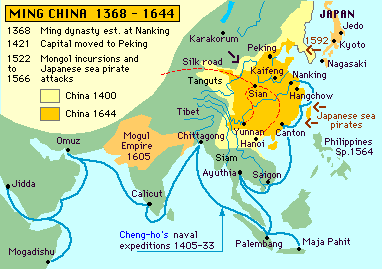
Taken
from http://www.chinapage.org/zhenghe.html
China’s retreat from the sea. In 1433, however, these Chinese naval expeditions suddenly ceased. For many years historians were puzzled by the reasons for this sudden withdrawal of Chinese interest in the world beyond their coasts. Most simply accepted that it was a reaction against the Mongols, a kind of xenophobia, or dislike and fear of other peoples. While there are elements of truth in this view, there were also some practical reasons for the decision to withdraw from the sea.
For one thing, a revival of power among the northern nomadic peoples once again forced the emperors to concentrate all their resources on defending the northern frontier. The overseas voyages and especially the maintenance of the navy were enormously expensive. Since their primary purpose was not trade, they did not even begin to pay for themselves.
In addition, the re-introduction of the Confucian
scholar-bureaucrats as the leading administrators of the empire led to a
growing conservatism. These scholars feared the process of innovation that
would come with more and more contact with the outside world. Moreover,
they generally resisted any activities that enhanced the power and
prestige of the court eunuchs, who were the emperor’s personal servants
outside the authority of the bureaucracy. With such considerations in
mind, the Confucian officials not only turned China in upon itself, but
even burned the records of Zheng He’s expeditions to prevent them from
being repeated.
Anxious to wipe out foreign influences and restore traditional Chinese values, the Ming dynasty tried to restrict overseas contacts.
The Early Qing
Dynasty
By the early 1600s the Ming dynasty was already beginning to show signs of weakness. As emperors became more and more involved in the court intrigues of the eunuchs and of the women of the imperial household, government was largely neglected. Without coordination from the top, although normal administration continued in the provinces such important affairs as maintaining the Grand Canal and other waterworks were allowed to slide. Soon rebellions began to rise throughout China. At the same time, the power of the “barbarians” in the north also began to grow again. Later Ming emperors bought peace from the nomads with larger and larger payments of tribute. Soon, the barbarians wanted even more.
Under Nurhachi, their leader, the nomadic warriors of Manchuria once again united and established a large empire on China’s northern frontier. Like other great conquerors, Nurhachi began his rise to power with the reorganization of his people for military purposes. He divided them into eight groups, each under a different colored flag, or “Banner.” Every individual was registered by name and occupation, and the banners were assigned enough land to support them. Captives taken in war soon replaced the Manchu men in the fields and in other non-military activities, thus freeing the Manchus themselves for solely military service. In effect, the Manchu system was rather like that of the ancient Spartans.
The “Banner” system. As Nurhachi expanded his power, eventually all Manchus were freed from manual labor and thus able to devote themselves entiurely to war. As his state expanded, Nurhachi also incorporated both Mongol tribesmen and even Han Chinese into the banner system, although Manchu bannermen, as they were called, remained the elite forces in his empire.
Heavily influenced by Chinese culture, Nurhachi turned to Chinese administrators to administer his empire along classic Chinese lines. As the Ming dynasty became increasingly weak, many Ming officials left their service and went to work for the strong Manchu dynasty. In addition to the security this provided them, they apparently appreciated the respect the Manchus had for Chinese civilization. Thus, unlike the Mongols, the Manchus were already in many ways a “Chinese” dynasty before they actually took control of the Ming Empire.
After taking all of the Ming’s lands northeast of the Great Wall,
as well as having made Korea a vassal state, in 1635 Abahai, Nurhachi’s
son, proclaimed the establishment of the Qing, or “Pure,” dynasty in
the Manchu Empire. In 1664, when the last Ming emperor committed suicide,
Abahai’s son seized the Chinese throne ostensibly to avenge the death of
the Ming emperor. Although most people in northern China accepted the new
dynasty, resistance long remained active in southern China, where secret
societies soon emerged dedicated to restoring the rightful Ming heir.
Nevertheless, the new Qing dynasty soon consolidated its control and ruled
China as the last of the imperial dynasties until 1911.
Qing administration. Anxious to maintain the loyalty of their newly conquered subjects, and already committed to Chinese styles of administration and culture, the Qing rulers essentially kept the old Ming bureaucracy and administration intact. They preserved the examination system, for example, although Manchu candidates were permitted to take special examinations that were not as difficult as those taken by the Chinese candidates. In addition, Manchu candidates for offices were given favored treatment. Although they remained a small minority in the much larger Chinese population, Manchus ultimately filled about 10 per cent of government offices, particularly at the top.
In the central government, for example, Qing emperors decreed that equal numbers of bannermen and Chinese should act as “grand secretaries” or advisers to the emperor. In addition, all the major departments of the government had both a Chinese and a Manchu minister sharing responsibility. In this way the Manchu emperors tried to use the Chinese officials to act as a check to the potential ambitions of Manchu subjects, and Manchu officials to act as check on potential Chinese rebellion. All official documents were issued in both Manchurian and Chinese until the Manchus gradually learned Chinese and lost the use of their own language.
Despite these efforts to include both Manchu and Chinese officials
in government, however, the Manchu emperors were at pains to make sure
that the Manchus remained separate and did not lose their identity among
the Chinese. For this reason, they decreed that intermarriage between
Manchus and Chinese was illegal. Thus the Manchus remained in many ways an
alien dynasty—more Chinese than the Mongols had been certainly, but not
quite as legitimate in the eyes of many Chinese as the Ming (weak though
they had been).
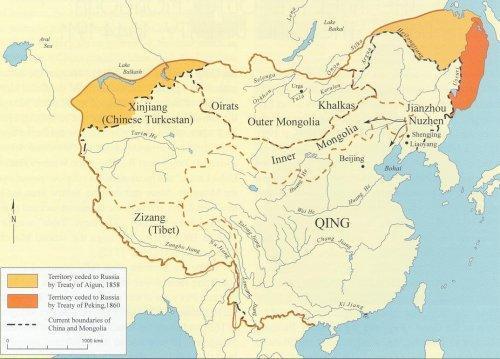
Qing Dynasty Map (AD 1644 to 1911 - 267 Years) Taken from http://www.paulnoll.com/China/Dynasty/dynasty-Qing.html